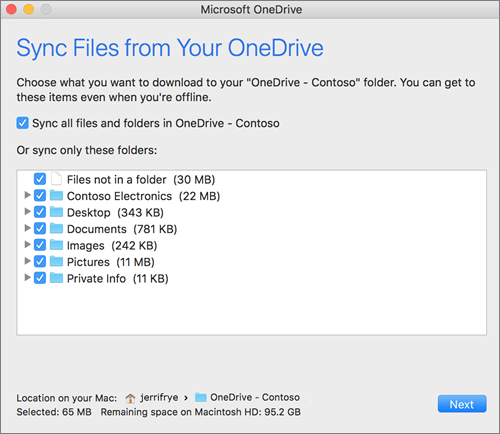

- #Onedrive for business mac sync client mac os x#
- #Onedrive for business mac sync client install#
- #Onedrive for business mac sync client download#
- #Onedrive for business mac sync client windows#
To rotate photos in OneDrive, open them in Preview, rotate them, and then save them. The changes will automatically be made in OneDrive and your other computers that have the OneDrive app installed. You can also use the Finder to rename and delete files, create new folders, and move files around in your OneDrive folder. If you installed the OneDrive app on other computers, the files will automatically be added to the OneDrive folders on them, too. Files you upload this way can be up to 10 GB in size. To upload files to OneDrive automatically, just copy or move the files to your OneDrive folder using the Finder, or save them in your OneDrive folder from an app. If you add, change, or delete a file or folder on the OneDrive website, the file or folder is added, changed, or deleted in your OneDrive folder and vice versa. This folder is kept in sync with OneDrive.
#Onedrive for business mac sync client install#
When you install the OneDrive app for Mac, a copy of your OneDrive is downloaded to your Mac and put in the OneDrive folder.
#Onedrive for business mac sync client mac os x#
NOTE: The OneDrive app requires Mac OS X 10.7.3 (Lion) or later. Here are answers to some frequently asked questions about the OneDrive app for Mac. This completes the set up process you will now see a OneDrive Business folder under your favorites within finder. The next screen will confirm the path you have chosen for the location of the OneDrive for Business folder. Choose the location for your OneDrive for Business folder (by default it will create it in the documents folder)Ĩ. Click and uncheck Hide Dock icon to remove it from the dockħ. Click and uncheck Open at login to prevent the client from opening at startup. Click Choose OneDrive for Business Folder Location Automatically open at log in and show/hide the dock iconĦ. Enter your MCCC email address for the user name and your MCCC passwordĥ. Click through the Get Started to begin the sync with the computer.ģ. Launch the program by double clicking on the OneDrive open command.Ģ. With OneDrive app closed run the appropriate terminal commands on this Microsoft Support page.ġ. Search for OneDrive and then click on get.
#Onedrive for business mac sync client download#
Download the sync client from the app store.Ģ. Accessing OneDrive for Business using a Mac can accessed on a college owned device by downloading and installing the client at:ĭownload: 1. OneDrive for Business is part of Office 365 and offers the ability to store files in the cloud, access them from multiple computers, and share them with others. Office 365 - OneDrive for Business Mac sync client usr/bin/defaults write /System/Library/User Template/English.lproj/Library/Containers/-mac/Data/Library/Preferences/ 365 - OneDrive for Business - Setting up Mac Client and FAQ - Print View Office 365 - OneDrive for Business - Setting up Mac Client and FAQ usr/bin/defaults write /System/Library/User Template/English.lproj/Library/Containers/-mac/Data/Library/Preferences/ DisablePersonalSync -bool TRUE usr/bin/touch /System/Library/User Template/English.lproj/Library/Containers/-mac/Data/Library/Preferences/

bin/mkdir -p /System/Library/User Template/English.lproj/Library/Containers/-mac/Data/Library/Preferences/ Stand Alone deployment turned out to be a challenge, since it has to be launched as the current user. JssLog "Microsoft OneDrive Defaults Configured" list /Users UniqueID | awk '$2 > 1000 " cfprefsd #Create a list of mobile user accounts who always have a UniqueID of greater than 1000 # OneDrive folder, and a SymLink created in the /Users/userid directory pointing to the new If the directories are present, then they are moved into the # already, then checks that the folders haven't already been migrated or symlinked to Checks if /Users/userid/OneDrive - Company folder exists # Migrates users' Documents and Desktop folders from their local home directory (/Users/userid) Here's what I have so far.it works and processes all local users, so long as they don't have any open files in Documents or Desktop folders: #!/bin/bash If anyone has experience with setting a default file path in a plist, and can check my work, that would be great. I want to turn this plist into a custom Configuration Profile to deploy to all my clients once I can test that it works.

However, I'm not sure if I set the DefaultFolder path string correctly.Īfter looking at other plists in my ~/Library/Preferences folder that point to specific file paths, I think I have the right syntax. So, following the instructions in the article " Configure the new OneDrive sync client on macOS," I've made the following plist.
#Onedrive for business mac sync client windows#
This new client enables users to also sync SharePoint folders to their Macs just like the Windows client. I'm trying to set up a plist that will have defaults settings for the new OneDrive Sync Client released 1/27/17.


 0 kommentar(er)
0 kommentar(er)
